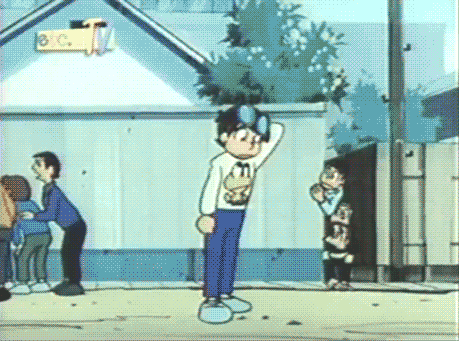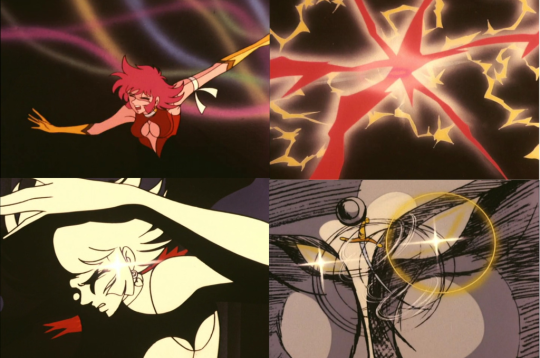originally posted at https://canmom.tumblr.com/post/656800...
Hello friends! It’s that time of the week.
This week it’s time to go a little oldschool, shine our spotlight on someone who is widely hailed as the most influential Japanese animator in the whole history of our medium: Yoshinori Kanada! (Apologies anyone who wanted a weeb break. I’ll try and give you one next week.)
Kanada was born in 1953, and rose to prominence in the 70s as one of the first animators to get an individual reputation as a distinctive ‘charisma animator’, earning him magazine interviews and inspiring fans to seek out his cuts across different productions.
(For this post I’m going to be leaning heavily on the research of Matteo Watzky, who just concluded a long series on Kanada and his successors. Big thanks to that guy!)
But he didn’t come out of nowhere. One of his major influences is the work of A Pro, one of the first major offshoots of Toei Animation back in the 1960s led by Daikichirō Kusube and Yasuo Otsuka. In contrast to Toei, who at the time tended to emphasise realism on films like Horus: Prince of the Sun, Otsuka’s style emphasised energetic comedy, doing everything they could to overcome the restrictions of limited animation with secondary action, irregular rhythms and strong poses. You can read about the details here…
Matteo writes:
it’s important to note that Kanada could be considered one of their students: it’s on (partly) A Pro shows like Akado Suzunosuke (1972-1974), Dokonjô Gaeru (1972-1974) and Kôya no Shônen Isamu (1973-1974) that he did some of his first in-betweening work, and even some key animation.
but he advised me on Twitter that Kanada didn’t actually work directly at A Pro, so my bad there!

Another major influence on Kanada can be traced to late 60s gekiga anime aimed at a slightly older audience like Star of the Giants, Ashita no Joe and Tiger Mask, whose animators started experimenting with photocopying drawings directly onto cels to create a much more rough, textured look, and layouts emphasising 3D motion and complex camerawork. Both would become a hallmark of Kanada’s style, and the recognition of their distinctive creators like Shingo Araki and Keiichirō Kimura helped lay the groundwork for the role of ‘charisma animator’.
So what of Kanada himself? He started, like pretty much all animators of the time, as an inbetweener (dougaman), drawing the final lineart and inbetweens prior to colouring. Apparently he despised this work, finding it tedious and repetitive, and part of the reason for his idiosyncratic timings when he became a key animator was to spare his inbetweeners the same fate.
Kanada’s early work was considered unremarkable and even unskilled by his peers like Takuo Noda, but he very rapidly rose to prominence around 1974, marked by his animation on a half-episode of Cutie Honey in which most of his stylistic flairs were present, at least in early form.

(stealing this image from Matteo since nobody seems to have gifed any of it)
So what is this Kanada style, or Kanada school? It’s hard to describe a graphic style in words, but if you wanted to point to a few elements associated with Kanada…
- extreme poses, designed more for drama than naturalistic motion
- highly varied frame timings, combined with big changes of pose to create really sharp, snappy movements
- impact frames and speed lines
- elaborate background animation sequences where the camera flies along tunnels or corridors
- shiny surfaces with complex specular highlight shapes
- bright lens flares
- complex fire effects with ropes and coils of flame (especially in the signature Kanada dragon, since homaged by of animators)
Of course, these didn’t appear as a package of course, but took time to develop. Kanada was not yet the star of the industry in 74 - that took a few more years, during which time Kanada worked at Toei, and then went to their major subcontractor No. 1 along with others in the aftermath of the strike, before finally founding his own studio Z2 with Shin’ya Sadamitsu and Kazuo Tomizawa in 1977. Z2 quickly gave way to Z3, and then that too folded Kanada returned to No. 1. Somewhere in this time, he did some of his definitive work on Galaxy Express 999, defining those ‘liquid fire’ explosions and creating all kinds of characterful mecha animation.
These years are notable mostly for the rapid evolution in the ‘Kanada school’ style. By this point this was not just one animator’s idiosyncratic style, but increasingly a movement of other ambitious young animators who’d been influenced by Kanada such as Masahito Yamashita, as they animated projects like Urusei Yatsura…
By the 80s, Kanada and a number of his proteges once again formed a studio of their own in the form of Kaname Pro, and it’s here that one of Kanada’s best known works, the Birth OVA, was made. Combining some absolutely astonishing animation with a chaotic, hard to understand sci-fi story about a girl on a hovering platform in a post-apocalyptic wasteland (notably very little of the writing on Birth bothers to say what it’s about!), it was very much an animator-first project… which means, however flawed, it should be a fascinating and unique artefact.
And… I’m out of time! Very frustrating; there are a million more things to say about Kanada’s later career and the million people he influenced since (not just in anime: he was also one of the inspirations for the superflat art movement), but the hour is upon us, so let’s get on and watch some films. Tonight our main features are going to be Birth and Galaxy Express 999, which showcase some of Kanada’s best known animation. If we end up with a surplus of time, I might yet put in some other Kanada stuff, we’ll play it a bit by ear.
Animation Night 62 will start very shortly, so hop on into twitch.tv/canmom and we’ll check out some 70s-80s classics from one of the greatest animators. And I’ll add finishing this post to the big list of ongoing projects ><
Comments